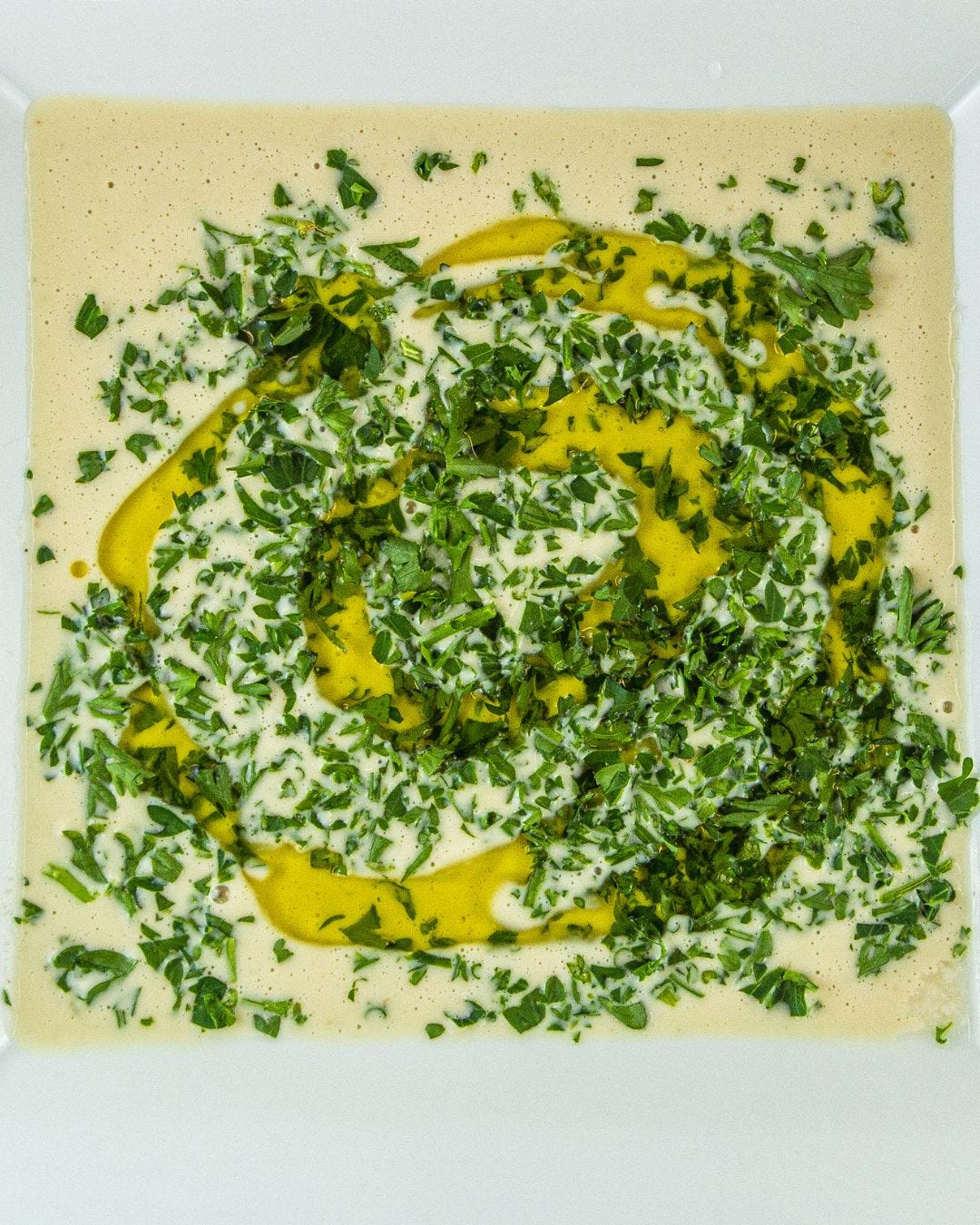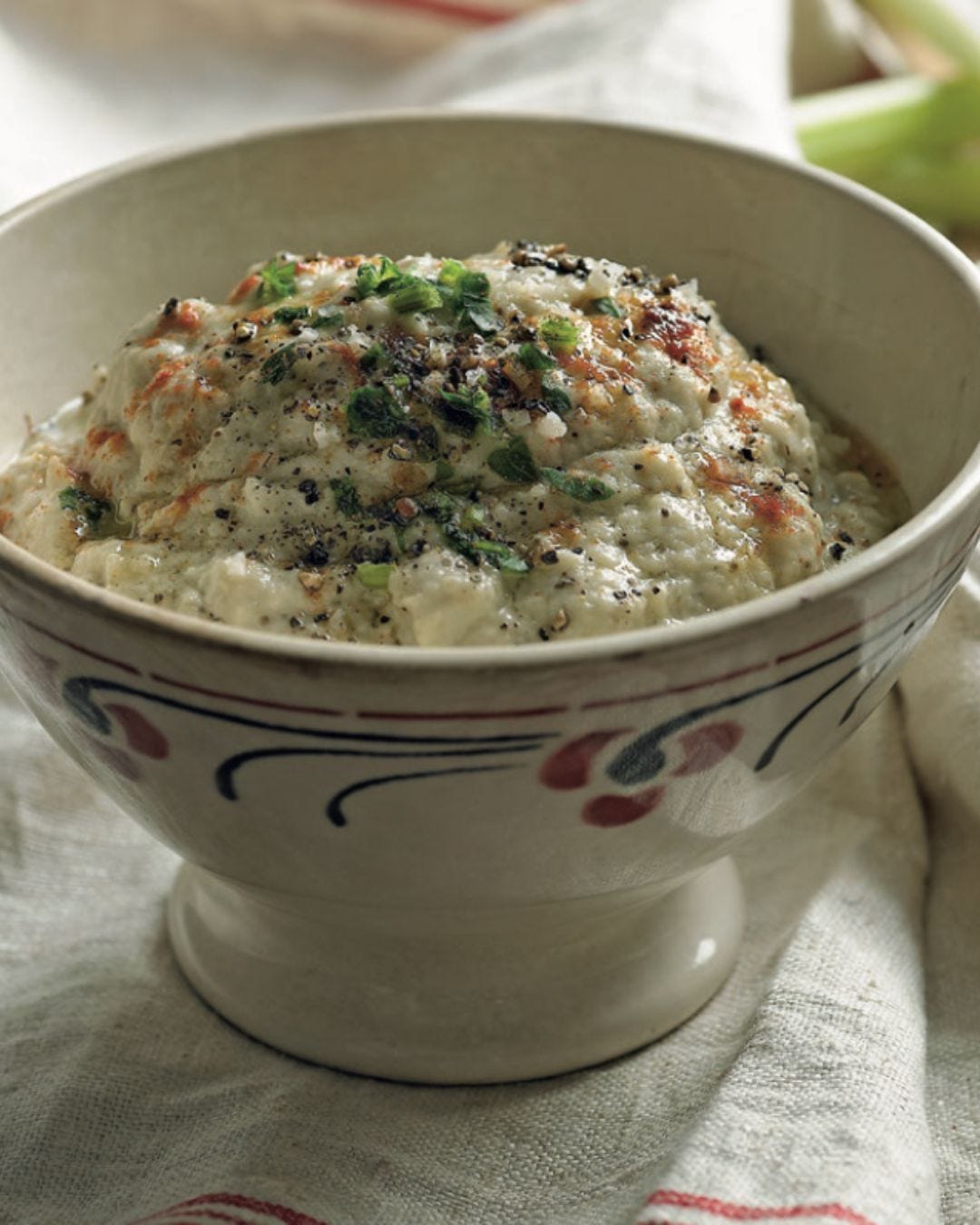How To Holistically Heal...With Three Simple Healthy Recipes
Tahini - Lemon Tahini Dressing, Baba Ganoush & Tahini Soup.
Experience this Newsletter in all its online glory. Go here
What Is Tahini?
Tahini is a creamy paste made from ground sesame seeds, one of the world’s oldest cultivated crops, native to the Middle East and parts of the Mediterranean. The name tahini comes from the Arabic word tahana, meaning “to grind,” reflecting the traditional stone-ground method used to create its smooth texture and nutty flavour. It’s a staple ingredient across many cuisines from Cypriot and Greek tahinosoupa (sesame soup) to Middle Eastern hummus (chickpea dip) and halva (a sweet made from tahini and honey).
Hulled vs Unhulled Tahini
The key difference lies in whether the outer husk (the seed coat) of the sesame seed is removed before grinding.
Hulled Tahini: Made from sesame seeds with the outer husk removed, resulting in a paler, smoother, and milder-tasting paste. It’s creamier and slightly less bitter, the variety most often used in dips, dressings, and desserts.
Unhulled Tahini: Made from whole sesame seeds with the husk intact, giving it a deeper colour, earthier flavour, and a more robust nutrient profile. The hull contains extra fibre, calcium, and other minerals, so unhulled tahini tends to be higher in nutritional value, though it’s also thicker and more bitter in taste.
From a health perspective, unhulled tahini offers more calcium, fibre, and minerals because the outer hull is intact but it also contains phytates (phytic acid), natural compounds that can bind to minerals such as calcium, iron, and zinc, reducing their absorption. While phytates are not inherently harmful, they also possess antioxidant and protective effects - excessive intake from unsoaked, unfermented seeds can make these minerals less bioavailable.¹ Lightly toasting or fermenting sesame seeds (as done in traditional preparations) can help lower phytate levels and improve mineral absorption.²
This means that while unhulled tahini is more nutrient-dense on paper, hulled tahini may provide minerals that are more readily absorbed, especially for those with compromised digestion or mineral deficiencies.
White vs Black Tahini
White Tahini: Usually made from lightly toasted or raw white sesame seeds, giving it a mild, versatile flavour perfect for salad dressings, sauces, and sweets.
Black Tahini: Made from black sesame seeds, prized in traditional Chinese and Japanese medicine for their high antioxidant content, particularly lignans and anthocyanins, which support healthy ageing, hair pigmentation, and liver detoxification.³ It has a more intense, slightly bitter flavour and is often used in both savoury and dessert recipes.
Both types are nutrient-dense sources of healthy fats, protein, and key minerals such as calcium, magnesium, zinc, and iron, supporting bone, skin, and hormone health.⁴
Choosing Organic
Always choose certified organic tahini made from 100 % sesame seeds, free from added oils, salt, or preservatives. Sesame crops are often treated with pesticides, so organic certification ensures a cleaner, more nutrient-intact product and a healthier ecosystem for pollinators and soil microbes. Organic tahini also tends to have a fresher, purer sesame aroma and flavour.
The Sesame Oil on Top — What To Do
It’s completely natural for the sesame oil to separate and rise to the top of the jar over time. This is a good sign, it means your tahini hasn’t been hydrogenated or artificially stabilised.
Before each use:
Stir the oil back through the paste until smooth.
Store in a cool, dark place (or the fridge if you prefer a thicker texture).
Never pour off or discard the oil, it contains valuable essential fatty acids and fat-soluble nutrients that make tahini so nourishing.
If the tahini has hardened or separated too much, place the jar in warm water for a few minutes to soften it before stirring.
1. Lemon Tahini Dressing - Recipe from our 21 Day Seasonal Cleanses)
Used as a dip or dressing for salads and vegetables. Delicious with any grilled meat.
Ingredients:
3 tablespoons hulled tahini
1 lemon, zest and juice
2 tablespoons water (adjust for desired consistency)
1 clove garlic, minced
Natural salt and pepper to taste
Drizzle with extra virgin olive oil to serve or stir through
Serve with chopped parsley or coriander leaves
Method:
In a bowl, combine the ingredients well until smooth.
Season with salt and pepper to taste.
Turn into a Green Lemon Tahini Dressing by adding finely chopped green herbs such as parsley, coriander, basil, mint etc. or adding all ingredients to a food processor.
2. Baba Ganoush (Blackened eggplant dip) - Recipe from my book I am Food - Eating Your Way To Health.
An ode to Lebanese home cooking, serve this dip with Tabouli sans grain on page 118 as a delicious accompaniment to meat or spread on crackers or vegetable sticks.
Ingredients
2 eggplants (aubergines)
3 cloves garlic, unpeeled
3 tablespoon fresh lemon juice
2 tablespoons olive oil, plus extra to serve
2 tablespoons hulled tahini
natural salt and freshly cracked pepper
3 tablespoons finely chopped flat-leaf parsley
paprika, to garnish
Method
Preheat the oven to 200°C (fan-forced).
Clean and prick the eggplants with a fork. Place in a roasting tin with the garlic cloves and roast for 20 minutes or until the skin has blackened and the eggplants have collapsed. Leave until cool enough to handle, then cut the eggplants in half and scoop out the flesh. Discard the skin. Pop the garlic out of its skin.
Place the eggplant flesh in a food processor and add the lemon juice, olive oil, tahini and garlic. Season with salt and pepper and blend until smooth. Sprinkle over the parsley and paprika and serve with a final drizzle of olive oil.
3. Tahinosoupa (Cypriot Tahini Soup)
Tahinosoupa is a warm, silky soup made from tahini (ground sesame paste), lemon juice, and broth, often thickened lightly with rice, bulgur, or crushed vermicelli noodles. It’s completely plant-based and naturally creamy without any dairy. It’s traditionally eaten during Lent and fasting periods when meat, dairy, and eggs are avoided, but it’s so delicious and restorative that many Cypriots enjoy it year-round. A nutritious soup to enjoy during a cleanse or detox.
Ingredients
¼ cup hulled tahini
1 litre warm vegetable or chicken broth
Juice of 1–2 lemons
2 cloves garlic, finely crushed (optional but traditional)
⅓ cup rice (or bulgur wheat or vermicelli)
Sea salt and pepper, to taste
Olive oil to serve with chopped parsley, fennel fronds or mint.
Method
In a small bowl, whisk tahini with lemon juice - it will seize and thicken.
Gradually add a ladleful of warm broth to the tahini-lemon mixture while whisking continuously until smooth and emulsified.
In a saucepan, bring the remaining broth to a gentle boil. Add rice, bulgur, or vermicelli and cook until soft.
Slowly pour the tahini mixture into the pot, stirring constantly to prevent curdling.
Lower the heat and warm through gently, do not boil. Season with salt.
Serve warm, sprinkled with parsley or mint, and a drizzle of extra virgin olive oil.
Check out my other Cypriot Recipes - Halloumi Three Ways.
References
Kumar V, Sinha AK, Makkar HPS, Becker K. Dietary roles of phytate and phytase in human nutrition: A review. Food Chem. 2010;120(4):945-959. doi:10.1016/j.foodchem.2009.11.052
https://www.thepharmajournal.com/archives/2022/vol11issue8S/PartG/S-11-7-463-390.pdf and Embaby HE-S. Effect of heat treatments on certain antinutrients and in-vitro protein digestibility of sesame seeds. Food Science & Technology Research. 2011;17(1):31-38. doi:10.3136/fstr.17.1_31
https://www.news-medical.net/health/Rooted-in-ritual-rising-in-wellness-The-story-of-black-sesame.aspx
Jafari A, Parsi Nezhad B, Rasaei N, et al. Clinical evidence of sesame (Sesamum indicum L.) products and its bioactive compounds on cardiovascular disease risk factors: a GRADE-assessed systematic review and dose–response meta-analysis. Nutrition & Metabolism. 2025;22:22. doi:10.1186/s12986-025-00910-7





